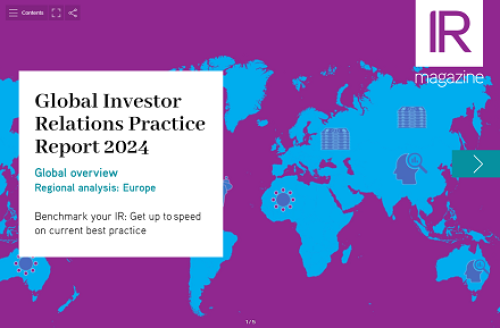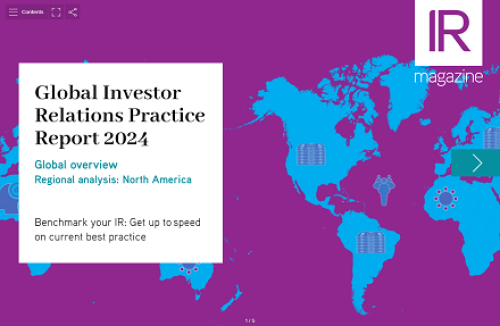Company to integrate annual review and sustainability report in a bid to shift its focus
Pfizer is regarded as one of the biggest corporate philanthropists in the US. It’s a label you’d imagine the company would be proud of, and it is. At the same time, however, it is not something it’s entirely comfortable with.
‘I think most people knew us as a very generous corporate donor,’ explains John Santoro, Pfizer’s head of stakeholder relations. ‘For example, we were the largest corporate donor for a couple of years in the US. But what we’re trying to do now is get beyond philanthropy. We truly have sustainability and corporate responsibility woven into our business operations and this is a very important part of the way we operate long term.
‘As part of this effort, Pfizer plans to incorporate its financial and sustainability reporting into one annual document. The company’s website will then become a resource for all the information on sustainability that doesn’t fit into the print edition. ‘Our corporate responsibility report comes out every two years, and our annual report comes out – obviously – every year (see Pfizer’s annual review, below),’ says Santoro. ‘Our vision is to have one unified report that spans both print and online. On the internet, people would then be able to drill down deeper on various topics that are of interest to them.
‘For example, you would not put everything you need to know about green chemistry in the full report because you have a lot of topics competing for a relatively small amount of space, but on the internet you can add many more links and much more information. We started that this year, with reasonable success.’
The move to integrate the reporting of business operations and corporate social responsibility is an interesting one, given the focus US companies have traditionally placed on corporate philanthropy. It appears as if US firms are coming round to a more European way of looking at sustainability; in Europe, there has been greater pressure on companies to integrate sustainable practices into their business operations and then report on their progress.
‘Companies overall are trying to get people to think about corporate responsibility as more than just philanthropy,’ comments Santoro. ‘I think the Europeans may be further ahead than the US in that area, but that is a route Pfizer is looking forward to following.’
Taking responsibility
The move will also please investors in socially responsible investment funds, which take a critical view of companies that believe corporate philanthropy – essentially donating cash and products to needy causes – equals corporate responsibility.
Santoro, while acknowledging the presence of socially responsible investors on Pfizer’s share register, says they were not a big consideration when making the decision to integrate the firm’s reporting. ‘They are a relatively modest part of our investment base, but they are an important part,’ he states. ‘Whether or not they are growing in importance, they represent a constituent that must be served – and we are out to serve them.’
The print editions of Pfizer’s reports are made available to the company’s 1.8 mn retail shareholders on request, notes Santoro. ‘We send them a card and if they want to see the print piece, they can send the card back and we can fulfill that request,’ he explains. ‘We used to mail the annual review to everybody but, over the past few years, we’ve moved more to a system whereby we send it in print to people who want to see it in print, and everybody else can see it online, which is what a lot of people prefer to do.’
Santoro sits outside Pfizer’s IR department, but collaborates with it closely on reporting projects. ‘We work very closely with the investor relations department to ensure everything lines up in terms of timing, schedules, governance and financials, including the footnoting – which is sometimes pretty extensive,’ he states.
Case study: Pfizer’s annual review
Most annual reviews shove the financial information to the back, but in Pfizer’s case that wasn’t possible. Its annual review – a 60-page document – can be read from both sides. As a result, the financials are tucked snugly in the middle.
‘You can start from the life side where we talk about Pfizer’s commitment to improving life at all stages,’ explains John Santoro, Pfizer’s head of stakeholder communications, who runs the pharmaceutical company’s annual review project.
‘Or you can start at the other end, at the science side, which details Pfizer’s commitment to science and scientific achievement in the name of medical advancement. And they meet in the middle, where you find the sections on management and financials.’
To complement the print version, Pfizer produced an online review that includes video testimonials from eight scientists and four other colleagues from the company. ‘They give a really good insight, particularly on the scientists’ side, into some of the challenges they’re facing and the excitement surrounding some of the treatments they’re working on for things like Alzheimer’s, diabetes and cancer,’ says Santoro.
For its annual review project, Pfizer worked in collaboration with Ideas on Purpose, a design firm based in New York. Pfizer and Ideas on Purpose have a relationship going back five years, comments Santoro. ‘We challenged it this year to put together a piece that really broke the mold, and it responded exceptionally well,’ he adds.










